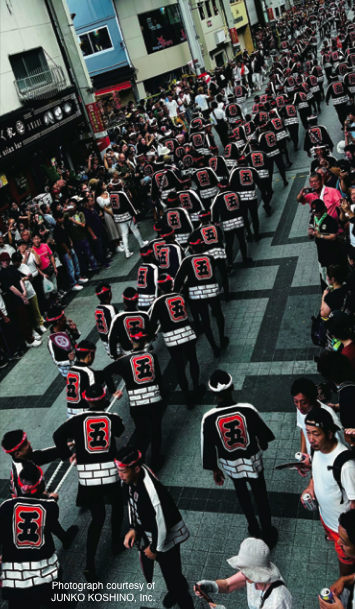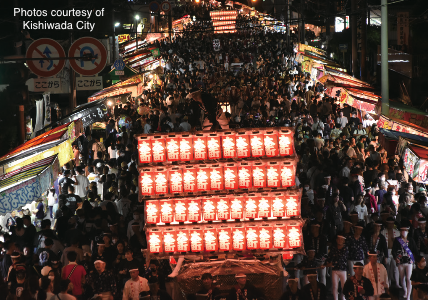Kishiwada Danjiri Matsuri
Recommended by Renowned Fashion Designer Junko Koshino
Junko Koshino, whose sisters Hiroko and Michiko are also acclaimed fashion designers, recounts that, aside from the influence of their mother, a dressmaker living in Kishiwada, Osaka had a large significance on her and her sisters when growing up. Kishiwada, Osaka is home to the most famous Danjiri Matsuri in Japan. Danjiri Matsuri is a Japanese cart-pulling festival, where large wooden carts (danjiri guruma) are designed to resemble shrines and temples. Various towns pull the carts at different speeds; some slowly, while others like Kishiwada have their partici- pants run as fast as they can. Though exciting, it can also be dangerous. Despite the risks, the 300-year-old festival is still greatly anticipated by locals. In an interview with Tokyo Journal ’s Miyuki Kawai and Editor-in-Chief Anthony Al-Jamie, Junko Koshino fondly recalls the festival and its impact on her family and the locals of Kishiwada.
TJ: We understand you grew up in Kishiwada. Can you tell us what it was like growing up in the town and your memories of Kishiwada?
KOSHINO: Kishiwada’s festival has been a major event for me since I was young. From the second floor of my mother’s house, which was on a shopping street with an arcade, it was high enough to see the carts of Danjiri Matsuri very well. When I had a boutique in Paris, I hardly came home for the festival. So, I listened to the music and shouts over the phone and got excited. The sound of drums and flutes always makes me feel nostalgic. My sisters and I come back home on the festival days, even now, whenever possible. During the COVID-19 pandemic, though, I missed it.
TJ: What are some of the key events or activities that take place during the festival? Which ones are your personal favorites?
KOSHINO: While the fast-paced powerful cart pulling in the day- time is worth watching, the slow carts decorated with lanterns that travel at night are also very beautiful. The music is also noteworthy.
TJ: Have you ever participated in the festival yourself? What was your experience like?
KOSHINO: I joined the float pullers between my fourth year of primary school and second year of high school. It was very fun, but difficult since the carts moved so fast, one person’s fall can lead to a human avalanche. But because I was good at sports in school and had confidence in my balance, I joined them every year. My elder sister was just watching the festival, and my younger sister was too busy playing tennis to participate in the festival.
TJ: How was last year’s Kishiwada Danjiri?
KOSHINO: Danjiri was held normally with no limitation due to COVID-19 for the first time in three years, and it was wonderful.
TJ: What changes have you noticed about the festival over the years?
KOSHINO: When I joined the pullers, girls were supposed to put their long hair together. These days, they do beautiful, braided hairstyles. It is so elaborate and artistic, and I look forward to seeing them from the second floor of my house.
TJ: What is the significance of the Kishiwada Danjiri Matsuri to the locals?
KOSHINO: The more than 300-year-old festival attracts almost 60 million people and is indispensable for the locals. Kishiwada High School, my old school, which is located next to the Kishiki Shrine, was where the carts were prepared for the festival. School was closed on the festival days, but now the festival is held on weekends.
TJ: What percentage of the city would you say gets involved?
KOSHINO: Only the residents can participate, and it is organ- ized very well by the township. Their matching uniform, happi, is a symbol of solidarity.
TJ: How many people pull one float? What are the different roles of participants in the festival?
KOSHINO: More than 300 people including cart pullers, instru- ment players and performers on the top of the cart are involved in each cart.
TJ: What kind of influence did Kishiwada Danjiri Matsuri have on you?
KOSHINO: Having a major event on the same day every year taught me to prepare on time. The habit of concentrating on my goals helps me a lot.
TJ: Is there anything you would recommend for foreigners visiting the Kishiwada Danjiri Matsuri to do while visiting Kishiwada?
KOSHINO: Only locals can join the cart pulling, but foreigners can still enjoy the atmosphere and excitement and there are many food stands in the area.
TJ: How far is Kishiwada from Osaka?
KOSHINO: Kishiwada is just a 15-minute drive from the Osaka International Airport, although it takes around 30 minutes from central Osaka by train.
TJ: Is there any food you recommend foreigners try?
KOSHINO: During the festival, we make light meals such as oden, takoyaki and okonomiyaki in our homes. I love okonomiyaki. I enjoy my favorite one with foie gras (liver of goose or duck) and eat with a knife and fork instead of chopsticks.
TJ: It has been described as the toughest and one of the most dan- gerous festivals in Japan. Is it safe for viewers? How can we watch and remain safe?
KOSHINO: Kankan (special seats for spectators where they can enjoy the most dynamic scenes, Yarimawasi (turning cart at a right angle)) is the best place to watch. To tell the truth, the shopping arcade where my house is located is the best position, but it is so crowded and too dangerous to come close to the moving carts. Also, Kishiwada Castle, where the carts move around before entering their own shrine, is the must-see sight.
TJ: What do you think makes the Kishiwada Danjiri Matsuri so special and unique compared to other festivals in Japan or world- wide?
KOSHINO: It is famous for powerful cart pulling, but it is not for releasing stress. It has developed knowledge and technology based on more than 300 years of history and tradition. I think it is one of the best festivals in the world.

岸和田だんじり祭
ファッションデザイナー・コシノジュンコが愛する故郷の祭り
コシノジュンコ氏の姉妹ヒロコ氏、ミチコ氏とも著名なファッションデザイナーであり、洋装店を営ん でいた母の影響もさることながら、生まれ育った岸和田という土地柄が姉妹に与えた影響は計り知 れない。岸和田市は、だんじり祭で知られる。岸和田だんじり祭は、曳行のスピードでは群を抜い ており、盛り上がる一方で危険でもある。それでもなお、この祭りは地元民になくてはならない存在だ。 『東京ジャーナル』編集長アントニー・アルジェイミーと川合美雪のインタビューで、コシノジュンコ 氏が岸和田だんじり祭への思い、家族や地元民に対する祭りの影響について語った。
TJ: 岸和田ご出身とお聞きしていますが、岸和田ならではと思われる経 験や思い出はありますか?
コシノ: 小さい頃から私にとってもだんじり祭は一大イベントでした。 アーケード商店街にある実家の2階からはだんじり祭の山車がよく見え ました。パリにブティックを出していた頃は、なかなか帰ることがかな わず、電話でお囃子や掛け声を聞いて高揚感を味わっていました。太鼓 や笛の音を聞くと、まさに血が騒ぐという表現がぴったりな感覚が体を 駆け巡ります。今も祭りの日には3姉妹が可能な限り実家に集まります。 コロナ渦の間は残念な思いをしました。
TJ: だんじり祭のハイライト、お気に入りを教えてください。
コシノ: 昼間の豪快な曳行も見応えがありますが、夜間の止まってしま いそうなほどゆっくり進む灯入れ曳行もとても美しいものです。昼の動 と夜の静、全く対極です。だんじり囃子の太鼓や篠笛の音色も見事です。
TJ: だんじり祭に参加した経験は?
コシノ: 小学生から高校 2 年まで曳行に参加していました。昼間の曳行 は非常に速く、一人でも転ぶと将棋倒しになってしまうので、俊敏でな いと加われないのですが、私は脚力にもバランス感覚にも自信があった ので毎年欠かさず一団に参加していました。姉はもっぱら見るだけ、妹 はテニスに忙しく祭りには参加しませんでしたね。
TJ: 去年のだんじり祭はいかがでしたか?
コシノ: 2022 年は3年ぶりにコロナ渦による制限なしで開催され、大 いに盛り上がりました。
TJ: 長年の間にだんじり祭に何か変化はありましたか?
コシノ: 曳行に加わる女の子は髪が邪魔になるので昔から束ねていまし たが、それがいつしか進化して、ドレッドヘアを超えるようなアートに なっています。今は、実家の特等席から見る女の子たちの髪形がとても 楽しみです。
TJ: 地元民にとってのだんじり祭の意味、意義をどうお考えになりま すか?
コシノ: 300 年以上の歴史と伝統を誇る祭りは、60 万人もの観光客を 魅了しますが、地元民にとっては、だんじり抜きに岸和田を語れないと いうほど不可欠なものです。私が卒業した岸和田高校は宮入りが行われる岸城神社のお隣だから、公立なのに祭り当日は休校になったくらいで す(現在は週末に開催)。
TJ: 町の人口のどれくらいが祭りに関わるのですか?
コシノ: 参加できるのは町民だけで、町ごとに非常に組織的に運営され ています。各町の法被は団結の象徴ですね。
TJ: 1台のだんじりを何人が引くのですか?どんな役割に分かれている のですか?
コシノ: 曳き手、鳴り物、大工方などが一丸となり、300 人以上で曳行 します。
TJ: だんじり祭はご自身にどういう影響を与えたと思いますか?
コシノ: 毎年決まった日に大きなイベントがあるということが、何をや るにしろダラダラせずに期限を設けるという姿勢を身につけさせてくれ たと思います。目標に向かって集中していくという習慣、ビジョンは仕 事のうえで役に立っています。
TJ: だんじり祭を訪れる外国人に、祭りの期間中に勧めたいことは?
コシノ: 地元民でないと曳行には参加できませんが、祭り期間中は屋台 もたくさん出ますし、一見の価値はあると思います。
TJ: お勧めの岸和田名物の食べ物は?
コシノ: 祭りの期間中、我が家では、いつでも食べられるおでんやお好 み焼きやたこ焼きなどが定番です。私自身もお好み焼きが大好きで、自
分でも作ります。私の特製お好み焼きはフォアグラ入りで、ナイフと フォークでいただきます。
TJ: 日本で最も危険な祭りの1つと言われていますが、観光客が安全に 見る方法は?
コシノ: “カンカン場”と呼ばれる特設観覧席からは、豪快な“やりまわし”(だんじりを直角に方向転換させること)がよく見えます。私の実家が ある商店街が一番の特等席ですが、だんじりに近すぎて危ないし大混雑 します。各町のだんじりが宮入り前に周辺を回る岸和田城周辺もお勧め スポットです。
TJ: 国内外のほかの祭りとの大きな違いは何だと思われますか?
コシノ: 荒々しい曳行で知られますが、決して鬱憤晴らしなどではなく、 300 年以上の歴史と伝統に裏打ちされた綿密な計画に基づくものです。 城下町ならではの知恵と技術が育んだ、“団結と勢い” の祭りと言える でしょう。私は世界一の祭りだと思っています。
 tj
tj
The complete article can be found in Issue #282 of the Tokyo Journal.


